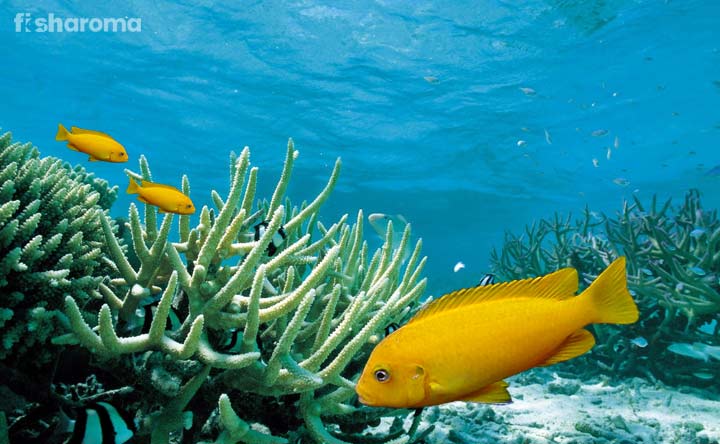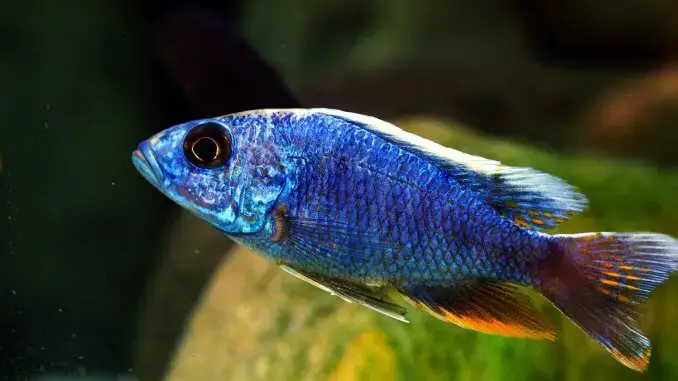Blue Bumblebee Cichlids, commonly found in Lake Malawi, Africa, are large fish with a robust body. Males can grow up to six inches in length, while females are slightly smaller, reaching around five inches.
These African cichlids belong to the mbuna group, known for their aggressive behavior and similar body shape. Bumblebee Cichlids are known to change color during breeding, with males turning a deep dark hue. Taking care of these unique fish requires proper knowledge and understanding of their specific needs.
We will explore the care guide and species profile of Blue Bumblebee Cichlids, discussing factors such as tank size, tank mates, and their ideal environment. Stay tuned to learn more about these fascinating cichlids and how to provide them with the best care possible.
Table of Contents
Tank Setup For Blue Bumblebee Cichlid
The ideal tank size for Blue Bumblebee Cichlid would be at least 30 gallons. It is important to maintain specific tank parameters for optimal care. The temperature should be around 78-82°F, pH level between 7. 8-8. 6, and hardness between 10-18 dGH.
It is recommended to decorate the tank with plenty of rocks and caves to provide hiding spots for the fish. These cichlids prefer a sandy substrate and some plants can be added as well. Keeping the tank clean and well-maintained is crucial for the health and well-being of Blue Bumblebee Cichlid.
Regular water changes and proper filtration system are necessary. Additionally, providing a balanced diet consisting of high-quality pellets, flakes, and occasional live or frozen foods will ensure the nutritional needs of the fish are met. With the right tank setup and care, Blue Bumblebee Cichlid can thrive and display their vibrant colors in your aquarium.
Blue Bumblebee Cichlid: Tank Mates And Compatibility
The Blue Bumblebee Cichlid is a fascinating fish that requires careful consideration when choosing tank mates. Suitable companions can include other peaceful cichlids such as the Demasoni Cichlid, while aggressive species like the Melanochromis Johanni should be avoided. Creating a harmonious community tank is essential for the well-being of all inhabitants.
By carefully selecting compatible tank mates, you can ensure a peaceful and enjoyable environment for your Blue Bumblebee Cichlid. Remember, these fish can change color during breeding, so be prepared for the stunning transformation that may occur. Overall, with proper planning and research, you can create a beautiful aquarium full of vibrant and compatible fish species.
Feeding And Nutrition For Blue Bumblebee Cichlid
The Blue Bumblebee Cichlid requires a carefully balanced diet to thrive and stay healthy. It is important to feed them the appropriate amount and frequency. Offering small portions of food multiple times a day is best. Live and frozen foods can be used to supplement their diet.
Providing a variety of food options ensures they receive the necessary nutrients. Avoid overfeeding as it can lead to obesity and health issues. Pay attention to the fish’s behavior and adjust the feeding accordingly. By providing the right diet, you can help promote the vibrant colors and overall well-being of your Blue Bumblebee Cichlid.
Blue Bumblebee Cichlid: Breeding And Behavior
The Blue Bumblebee Cichlid is known for its striking blue coloration and unique breeding behavior. Understanding the mating behavior of these fish is crucial in successfully breeding them. Creating the right conditions for breeding involves providing a spacious tank with plenty of hiding spots and a balanced diet rich in protein.
Caring for the fry requires careful monitoring of water parameters, regular feeding, and providing adequate space for their growth. As the Blue Bumblebee Cichlid can grow quite large, with males reaching up to six inches and females slightly smaller, proper care and maintenance are essential for their long-term health and well-being.
These beautiful fish are often referred to as “mbuna,” a term used to describe aggressive African cichlids with a similar body shape and temperament. By understanding their unique breeding behavior and providing the right conditions, aquarists can enjoy the beauty and charm of Blue Bumblebee Cichlids in their aquarium.
Blue Bumblebee Cichlid: Common Diseases And Health Issues
The Blue Bumblebee Cichlid is prone to several common diseases and health issues. Identifying these diseases is crucial in ensuring the well-being of the fish. Preventive measures, such as maintaining good water quality, providing a balanced diet, and preventing overcrowding, can help keep the cichlids healthy.
Regular observation and monitoring of the fish’s behavior and appearance can also aid in early disease detection. If a health issue arises, prompt treatment is essential to prevent further complications. Proper medication, quarantine, and isolation of infected fish may be necessary.
Consulting with a veterinarian or an experienced fish keeper can provide valuable guidance in treating common health issues in Blue Bumblebee Cichlids. By staying vigilant and proactive, fish keepers can ensure the longevity and vitality of their Blue Bumblebee Cichlids.

Credit: fisharoma.com
Blue Bumblebee Cichlid: Tips For Optimal Care
The Blue Bumblebee Cichlid requires optimal care to thrive in your aquarium. Water maintenance and filtration are crucial aspects to consider. Regular monitoring and observation of water parameters like temperature and pH levels are important. Proper handling and acclimation of the Blue Bumblebee Cichlid are also essential for its well-being.
It is best to avoid commonly overused terms and phrases in your writing to make it more engaging and unique. Additionally, make sure to provide a variety of expressions to maintain the reader’s interest. Proper care and attention to these factors will ensure that your Blue Bumblebee Cichlid thrives in its new environment.
Frequently Asked Questions Of Blue Bumblebee Cichlid
How Big Do Bumblebee Cichlids Get?
Bumblebee cichlids can grow up to six inches for males and around five inches for females.
Is A Bumblebee Cichlid A Mbuna?
Yes, a bumblebee cichlid can be classified as a mbuna due to their similar body shape and aggressive nature.
Why Do Bumblebee Cichlids Change Color?
Bumblebee cichlids change color during breeding. Males turn dark, and this change is triggered by a big water change.
How Big Do Blue Cichlids Get?
Bumblebee cichlids can grow up to 6 inches long for males and slightly smaller for females.
Conclusion
The Blue Bumblebee Cichlid is a fascinating and beautiful species that is worth considering for your aquarium. With its striking blue and yellow coloration, it adds a vibrant pop of color to any tank. With proper care and a suitable tank setup, these cichlids can thrive and bring joy to any fish keeper.
They are relatively easy to care for and can adapt to a wide range of water conditions. It is important to provide them with plenty of hiding spots and a balanced diet to ensure their health and well-being. Remember, these cichlids are known for their territorial behavior, so it is essential to choose their tank mates carefully.
Overall, the Blue Bumblebee Cichlid is a fantastic addition to any freshwater aquarium, bringing beauty, personality, and excitement to your aquatic ecosystem.
References
The International Discus Association (IDA)
The Discus World International (DWI)
The South American Cichlid Association (SACA)
The American Cichlid Association (ACA)
Please check other articles on this website, I have listed some of them here:
Electric Blue Acara: The Ultimate Guide To Care And Keeping
Best Fish for a 40 Gallon Tank: Top Choices for a Thriving Aquarium
Simple Guide to Easy-to-Care-for Aquarium Plants
Discover the Diverse Corydoras Catfish Varieties- A Guide
Get to Know Various Types of Algae Eaters
Master Guide: Best Water Parameters for Goldfish Care 2023-24
Mastering Black Ghost Knife Fish Care: A Comprehensive Guide
Optimal pH Levels for Tropical Fish: Essential Aquarium Guide
Discovering Freshwater Snail Species: An In-depth Guide
Expert Tips for Breeding Guppies: Keys to Successful Fishkeeping
Discover Peaceful Community Fish: Your Guide to Calm Aquatics
Ultimate Guide to Live Food for Betta Fish — Healthy Choices
Complete Guide to Your Perfect Cichlid Tank Setup
Your Guide to the Best Substrate for Planted Aquariums
Essential Guide to Discus Fish Care: Help Your Pets Thrive!
Grow Your Own Eden: Beginner-Friendly Aquascaping Plants Guide
Perfect Neon Tetra Tank Mates: Guide to Aquarium Harmony
Product Review of Eheim Classic vs Professional
The Ultimate Guide to Discus Fish Care
What Fish Can Live With Discus?
Ideal pH for Discus Fish | Aquarium Water Guide
How to Sex Discus Fish?: A Simple Guide for Hobbyists
Complete Discus Fish Tank Setup Guide
Can Discus Fish Live With Angelfish? The Complete Guide
Discus Diet Guide: What Do Discus Fish Eat?
Are Discus Fish Hard to Keep? Insights & Tips.
Optimal Discus Fish Water Parameters Guide
Discus Fish Size Guide 2024: How Big Do Discus Fish Get?
Ultimate Million Fish Guppy Care Guide 2024
Simple Guide to Easy-to-Care-for Aquarium Plants
Grow Your Own Eden: Beginner-Friendly Aquascaping Plants Guide
Hornwort Aquarium Plants: The Ultimate Guide to Care and Maintenance
Aquarium Equipment for Beginners: The Complete Checklist
Feeding Your Aquarium Fish: The Complete Guide
Common Beginner Fishkeeping Mistakes and How to Avoid Them!
Aquarium Plants for Beginners: Easy Care and Beautiful Options
Keeping Your Aquarium Water Clean and Healthy: The Complete Guide
Breeding Aquarium Fish: A Comprehensive Guide
Marine Aquariums: The Ultimate Challenge for Experienced Hobbyists
Tech in the Tank: Must-Have Gadgets for Aquarium Automation
Dwarf Sucking Catfish : The Ultimate Guide to Keeping and Caring for Oto Catfish
The Science of Aquarium Water Chemistry: Understanding pH, KH, and GH
Veiltail Goldfish: The Exquisite Beauty of Flowing Fins
Perfect Neon Tetra Tank Mates: Guide to Aquarium Harmony
Goldfish Care: Beyond the Bowl – Everything You Need to Know
Master Red Tail Shark Care: Tips, Tank Mates & Surprising Traits!
Sheepshead Wrasse Facts & Habitat Guide
Unveiling the Unique Asian Sheepshead Wrasse: A Fascinating Reef Fish with Quirky Behavior
Peacock Wrasse: A Dazzling Addition to Your Aquarium
Vibrant Wrasse Fish: Care Guide & Species Info
Bluestreak Cleaner Wrasse – Vibrant Reef Ally
Coris Wrasse Care Guide for Saltwater Aquariums
Melanurus Wrasse Care Guide & Habitat Tips
I am a passionate aquarist with over 30 years of hands-on experience in fishkeeping. My journey began at a young age, collecting fish from the wild and learning through experimentation. Specializing in tropical fish, I bring a deep understanding of the hobby to FishKeepingMadeSimple. The site provides honest, detailed reviews of essential products and accessories to help fellow enthusiasts create the best environments for their fish.









